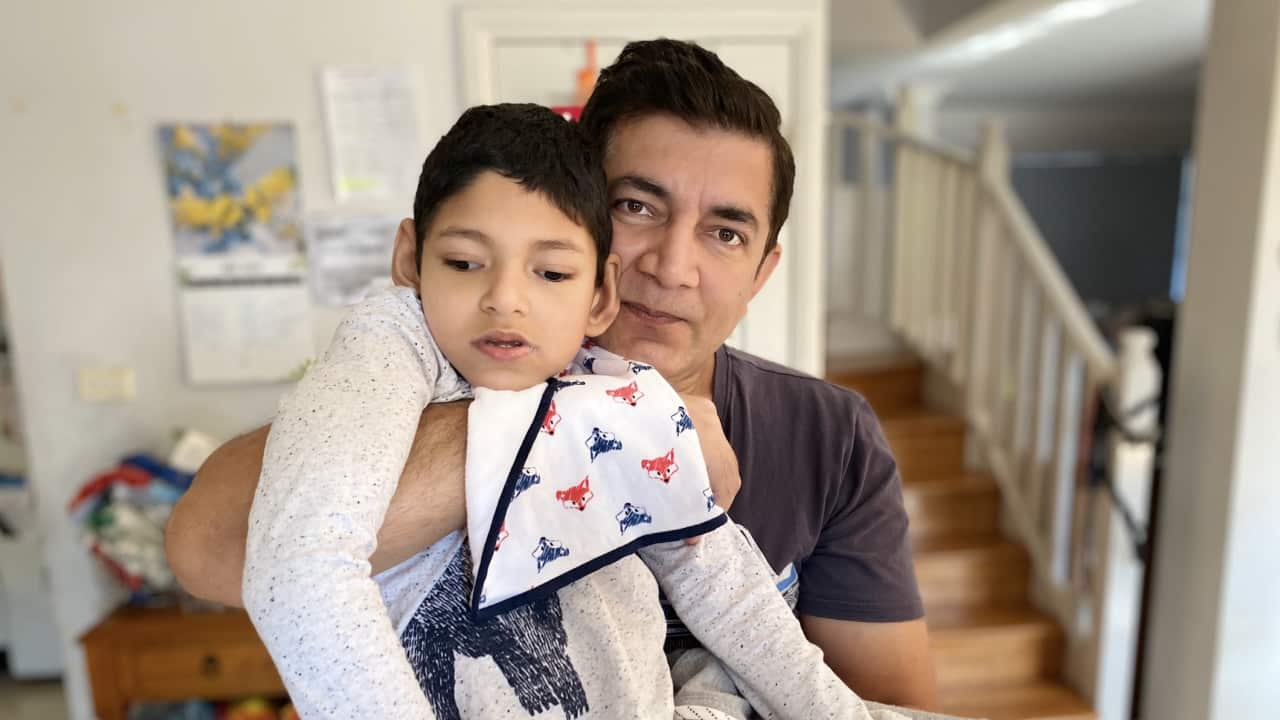For children living with epidermolysis bullosa (EB), even five minutes spent playing outdoors can be extremely dangerous.
Sydney-based siblings Nur Siddiqah Azny, eight, and Muhammad Azraqee Azny, five, were diagnosed at birth with the rare genetic disease that causes blistered skin and is likened to living with third-degree burns.
Medical experts often refer to those with the condition as "butterfly children" because of their skin's fragility which peels at the slightest touch.
Nur and Muhammad's parents, Ida Azny and Mohd Aidil Aim, were both unknown carriers of the mutated gene. "It was confusing because we'd never heard about epidermolysis bullosa before," Ms Azny told SBS News.
"It was confusing because we'd never heard about epidermolysis bullosa before," Ms Azny told SBS News.

The family moved from Malaysia to Australia to better care for their two children. Source: SBS
"When Nur was born, she was missing 75 per cent of skin on her body,"
Every day, the children - who have recessive dystrophic EB - must endure having their entire bodies dressed with bandages - a painful process that takes several hours.
"It's because they're always covered in lesions and wounds so we have to change their wound dressings."
The Azny family moved to Sydney from Malaysia in 2017 to take part in a clinical trial, which has since ended.
They came to Australia on a medical visa and hope to stay permanently. While researchers are yet to find a cure for the disease, Ms Azny said the support and acceptance they've received in Australia have dramatically improved their lives.
While researchers are yet to find a cure for the disease, Ms Azny said the support and acceptance they've received in Australia have dramatically improved their lives.

Muhammad Azraqee has blisters on 70 per cent of his body. Source: SBS
"We've had people back at home [in Malaysia] just come up to us and say 'did you throw hot water on them? What happened to your kids, was there a fire?', she said.
"When we explain to them to about how it is genetic and how it's actually inherited, they don't understand what that means and they think it's infectious or something that we did wrong.
"I don't see my children as a burden, I see them as someone who actually taught me how it is to be a good person."
Not-for-profit organisation DEBRA Australia supports people living with EB. Its general manager Lise Angus says up to 1,000 people are living with a type of the disease in Australia and about half a million people are worldwide.
"Everybody is working towards a cure globally, but the cure is a way off so in the meantime it's about ensuring that quality of life is really the best it can be for those living with it," she said.
"As DEBRA Australia we support them emotionally and physically ... including at-hospital and in-home nurses to help with dressings so that parents can just be parents and love their children and not inflict pain." At 40 years of age, Brisbane resident Dean Clifford has defied the odds by surviving decades longer than doctors expected.
At 40 years of age, Brisbane resident Dean Clifford has defied the odds by surviving decades longer than doctors expected.

The siblings are covered in painful blisters that need bandaging every day. Source: SBS
"I was given a life expectancy of anywhere between two to five years at most," he said.
"Worldwide, I'm sort of regarded as one of the oldest having the most severe version of EB that they have on record." Mr Clifford said his fighting spirit is what keeps him going and he hopes to inspire others living with the disease to never give up.
Mr Clifford said his fighting spirit is what keeps him going and he hopes to inspire others living with the disease to never give up.

Dean Clifford, 40, is one of the oldest known people in the world living with EB. Source: SBS
"It can be as much a mental game as it is a physical game, so I try to hang out with the younger generation and show them the possibilities of what you can achieve even though our skin is extremely fragile and extremely delicate," he said.
Despite struggling to open the lid of a milk bottle, Mr Clifford regularly visits the gym and has managed to achieve a personal best bench-pressing record of 150kg.
"The first time I ever lifted a weight, I almost lifted my body weight and my friends stood back in amazement," he said.
"We worked out that very short bursts of energy have very little side effects on my skin." A number of clinical trials to better treat the symptoms of the disease are currently underway in Europe and North America, including at Stanford University in California.
A number of clinical trials to better treat the symptoms of the disease are currently underway in Europe and North America, including at Stanford University in California.

Dean Clifford was not expected to live past the age of five. Source: SBS
The therapy uses a topical treatment to restore the production of type VII collagen, a crucial protein for skin integrity that those with EB are missing.
At the University of South Australia, researchers are developing a new antibody therapy for blistering wounds.
"We’ve identified a harmful protein in the skin of these patients and we have shown that applying our therapy in a gel/cream improves the healing of these patients and also prevents skin cancer development," Professor Dr Zlatko Kopecki said.
"We are seeing very promising results."
The research project received a funding boost of $30,000 from DEBRA earlier this year.
Dr Kopecki said he is hopeful the study will progress to human trials in the next two years.










